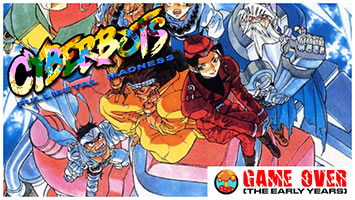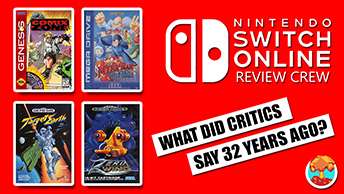- CLASSIC MAGAZINES
- REVIEW CREW
A show recapping what critics thought back
when classic games first came out! - NEXT GENERATION'S BEST & WORST
From the worst 1-star reviews to the best
5-stars can offer, this is Next Generation! - NINTENDO POWER (ARCHIVE)
Experience a variety of shows looking at the
often baffling history of Nintendo Power! - MAGAZINE RETROSPECTIVE
We're looking at the absolutely true history of
some of the most iconic game magazines ever! - SUPER PLAY'S TOP 600
The longest and most ambitious Super NES
countdown on the internet! - THEY SAID WHAT?
Debunking predictions and gossip found
in classic video game magazines! - NEXT GENERATION UNCOVERED
Cyril is back in this spin-off series, featuring the
cover critic review the art of Next Generation! - HARDCORE GAMER MAGAZING (PDF ISSUES)
Download all 36 issues of Hardcore Gamer
Magazine and relive the fun in PDF form!
- REVIEW CREW
- ELECTRONIC GAMING MONTHLY
- ELECTRONIC GAMING MONTHLY RANKS
From Mario to Sonic to Street Fighter, EGM
ranks classic game franchises and consoles! - ELECTRONIC GAMING MONTHLY BEST & WORST
Counting down EGM’s best and worst reviews
going year by year, from 1989 – 2009! - ELECTRONIC GAMING BEST & WORST AWARDS
11-part video series chronicling the ups and
downs of EGM’s Best & Worst Awards!
- ELECTRONIC GAMING MONTHLY RANKS
- GAME HISTORY
- GAME OVER: STORY BREAKDOWNS
Long-running series breaking down game
stories and analyzing their endings! - A BRIEF HISTORY OF GAMING w/ [NAME HERE]
Real history presented in a fun and pithy
format from a variety of game historians! - THE BLACK SHEEP
A series looking back at the black sheep
entries in popular game franchises! - INSTANT EXPERT
Everything you could possibly want to know
about a wide variety of gaming topics! - FREEZE FRAME
When something familiar happens in the games
industry, we're there to take a picture! - I'VE GOT YOUR NUMBER
Learn real video game history through a series
of number-themed episodes, starting at zero! - GREAT MOMENTS IN BAD ACTING
A joyous celebration of some of gaming's
absolute worst voice acting!
- GAME OVER: STORY BREAKDOWNS
- POPULAR SHOWS
- DG NEWS w/ LORNE RISELEY
Newsman Lorne Riseley hosts a regular
series looking at the hottest gaming news! - REVIEW REWIND
Cyril replays a game he reviewed 10+ years
ago to see if he got it right or wrong! - ON-RUNNING FEUDS
Defunct Games' longest-running show, with
editorials, observations and other fun oddities! - DEFUNCT GAMES QUIZ (ARCHIVE)
From online quizzes to game shows, we're
putting your video game knowledge to the test!- QUIZ: ONLINE PASS
Take a weekly quiz to see how well you know
the news and current gaming events! - QUIZ: KNOW THE GAME
One-on-one quiz show where contestants
find out if they actually know classic games! - QUIZ: THE LEADERBOARD
Can you guess the game based on the classic
review? Find out with The Leaderboard!
- QUIZ: ONLINE PASS
- DEFUNCT GAMES VS.
Cyril and the Defunct Games staff isn't afraid
to choose their favorite games and more! - CYRIL READS WORLDS OF POWER
Defunct Games recreates classic game
novelizations through the audio book format!
- DG NEWS w/ LORNE RISELEY
- COMEDY
- GAME EXPECTANCY
How long will your favorite hero live? We crunch
the numbers in this series about dying! - VIDEO GAME ADVICE
Famous game characters answer real personal
advice questions with a humorous slant! - FAKE GAMES: GUERILLA SCRAPBOOK
A long-running series about fake games and
the people who love them (covers included)! - WORST GAME EVER
A contest that attempts to create the worst
video game ever made, complete with covers! - LEVEL 1 STORIES
Literature based on the first stages of some
of your favorite classic video games! - THE COVER CRITIC
One of Defunct Games' earliest shows, Cover
Critic digs up some of the worst box art ever! - COMMERCIAL BREAK
Take a trip through some of the best and
worst video game advertisements of all time! - COMIC BOOK MODS
You've never seen comics like this before.
A curious mix of rewritten video game comics!
- GAME EXPECTANCY
- SERIES ARCHIVE
- NINTENDO SWITCH ONLINE ARCHIVE
A regularly-updated list of every Nintendo
Switch Online release, plus links to review! - PLAYSTATION PLUS CLASSIC ARCHIVE
A comprehensive list of every PlayStation
Plus classic release, including links! - RETRO-BIT PUBLISHING ARCHIVE
A regularly-updated list of every Retro-Bit
game released! - REVIEW MARATHONS w/ ADAM WALLACE
Join critic Adam Wallace as he takes us on a
classic review marathon with different themes!- DEFUNCT GAMES GOLF CLUB
Adam Wallace takes to the links to slice his way
through 72 classic golf game reviews! - 007 IN PIXELS
Adam Wallace takes on the world's greatest spy
as he reviews 15 weeks of James Bond games! - A SALUTE TO VAMPIRES
Adam Wallace is sinking his teeth into a series
covering Castlevania, BloodRayne and more! - CAPCOM'S CURSE
Adam Wallace is celebrating 13 days of Halloween
with a line-up of Capcom's scariest games! - THE FALL OF SUPERMAN
Adam Wallace is a man of steel for playing
some of the absolute worst Superman games! - THE 31 GAMES OF HALLOWEEN
Adam Wallace spends every day of October afraid
as he reviews some of the scariest games ever! - 12 WEEKS OF STAR TREK
Adam Wallace boldly goes where no critic has
gone before in this Star Trek marathon!
- DEFUNCT GAMES GOLF CLUB
- DAYS OF CHRISTMAS (ARCHIVE)
Annual holiday series with themed-episodes
that date all the way back to 2001!- 2015: 30 Ridiculous Retro Rumors
- 2014: 29 Magazines of Christmas
- 2013: 29 Questionable Power-Ups of Christmas
- 2012: 34 Theme Songs of Christmas
- 2011: 32 Game Endings of Christmas
- 2010: 31 Bonus Levels of Christmas
- 2009: 30 Genres of Christmas
- 2008: 29 Controls of Christmas
- 2007: 34 Cliches of Christmas
- 2006: 33 Consoles of Christmas
- 2005: 32 Articles of Christmas
- 2004: 31 Websites of Christmas
- 2003: 29 Issues of Christmas
- 2002: 28 Years of Christmas
- 2001: 33 Days of Christmas
- NINTENDO SWITCH ONLINE ARCHIVE
- REVIEW ARCHIVE
- FULL ARCHIVE
The Death of the Game System Review
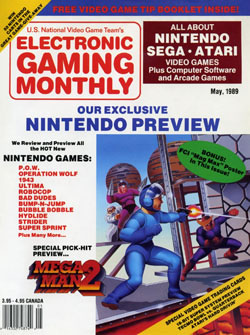
This is where Electronic Gaming Monthly came from, it's hard to believe that twenty years later it's all coming to an end!
Sadly, the EGM of today was not the same as the EGM of yester-year. Sure they continued to have game reviews, misleading previews and the questionably accurate Quarterman section, but some of the best elements of Electronic Gaming Monthly were killed off long before Dan "Shoe" Hsu and Shane Bettenhausen ever showed
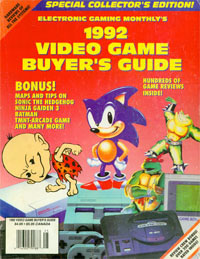
In the early days of the Video Game Buyer's Guide EGM would PhotoShop together different clip art and game systems to make ugly covers like this one!
For many EGM readers the most exciting time of the year was October, when the editorial staff would come together to produce their annual "Video Game Buyer's Guide." I know I have spent a lot of time bashing the very ideas of a video game buyer's guide, but this was a buyer's guide unlike anything you have seen before. And since EGM was the only magazine doing this, the idea of having a separate 13th issue on top of the standard subscription was more than my young brain could handle.
But it wasn't the buyer's guide itself that made me happy. Understandably, half of the magazine was made up of recycled game previews and reviews from their past issues. That is, if you were a
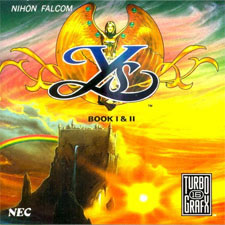
Does Y's Book I & II deserve a perfect 10? Of course it does ... but so does Tetris!
The origins of the EGM Video Game Buyer's Guide came from issue five, the very same issue that gave Tetris a 7 and Y's Book I & II a 10. In what now seems like an obvious move, the magazine decided to publish a special list of the best and worst games of 1989. The very

You get a car, and you get a car, and you get a car. EVERYBODY GETS A CAR!!
A year later EGM would turn this five page special feature into its own magazine, adding that one ingredient that made the whole thing make sense. Although it was small, the two (sometimes three) page system reviews are what prompted people to run out and buy these buyer's guides. People waited all year for this thing, much like an Oprah audience waits all
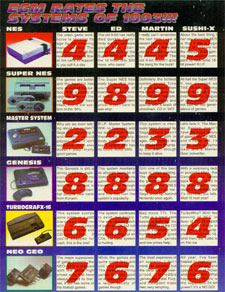
The annual Video Game Buyer's Guide was a fantastic way to end arguments about which system was the best and worst (assuming that you would rather substitute their judgment for your own)!
Part of what made the EGM buyer's guides so interesting was that they came out at a time when the Super NES and Sega Genesis battle was just starting. For example, in 1991 all of the critics gave the Sega Genesis 9s, while the Super NES received three 8s and a 7. Nintendo fanboys were shocked; the only comfort for them was knowing that most of the critics hoped that the system's library would improve. However, even that wasn't much condolence when you read comments like this directed at the Genesis: "The best games, the most games and the best deal for a 16-bit system! With loads of hot titles and the Mega CD due out next year, it's obvious Genesis is a Super NES killer in 1992."

In the mid-1990s it looked like EGM wasn't even trying any more, they just continued to use the exact same layout with very similar games taking up the coveted cover real estate!
These reviews continued into the 32-bit era, where EGM gave the Sony PlayStation a 10 and the Sega Saturn a 6. In fact, as the years went on this section grew from a two or three page affair to something that was as big as 20 pages. Like the standard game reviews, these system reviews became bigger and more detailed as new review crew staffers joined the magazine. By this time the Video Game Buyer's Guide was one of EGM's best known (and most loved) issues, the kind of thing that people waited all year for.
But sadly all good things have to come to an end. As EGM entered the 21st century they decided to scrap some of the features
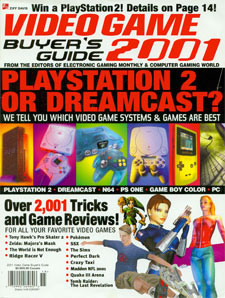
This 2002 Video Game Buyer's Guide was the very last time EGM used that name. In 2002 the name switched to the Holiday Game Guide For PC and VIdeo Games before ultimately dying!
Despite the success of these issues, no other mainstream magazine ever decided to review the game systems. Perhaps it's because they were afraid of angering the console makers, or maybe they just didn't see the point, but whatever the reason they missed a golden opportunity to pick up what EGM had left behind. Although it's a small thing, I sometimes wish there was a magazine today that would still score each of the "living" game systems. Then again, these days maybe I should just hope and pray that there are any game magazines around, let alone one that reviews game systems. Rest in peace, EGM Video Game Buyer's Guide.



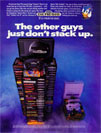


HOME |
CONTACT |
NOW HIRING |
WHAT IS DEFUNCT GAMES? |
NINTENDO SWITCH ONLINE |
RETRO-BIT PUBLISHING
Retro-Bit |
Switch Planet |
The Halcyon Show |
Same Name, Different Game |
Dragnix |
Press the Buttons
Game Zone Online | Hardcore Gamer | The Dreamcast Junkyard | Video Game Blogger
Dr Strife | Games For Lunch | Mondo Cool Cast | Boxed Pixels | Sega CD Universe | Gaming Trend
Game Zone Online | Hardcore Gamer | The Dreamcast Junkyard | Video Game Blogger
Dr Strife | Games For Lunch | Mondo Cool Cast | Boxed Pixels | Sega CD Universe | Gaming Trend
Copyright © 2001-2025 Defunct Games
All rights reserved. All trademarks are properties of their respective owners.
All rights reserved. All trademarks are properties of their respective owners.














